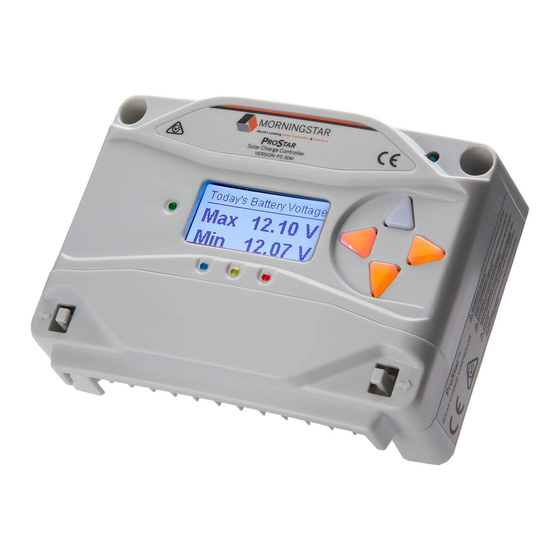
Advertisement
Morningstar Positive Ground Technical Note
Overview
Morningstar offers many solar charge controllers that are ideal for telecom applications. This can range
from low power requirements with the ProStar and ProStar MPPT controllers for 24V systems to higher
power 24V or 48V systems with TriStar and TriStar MPPT controllers. For very high power systems
controllers can easily be configured to charge the battery bank in parallel. Digital data output is standard
with these controllers for monitoring so they are ideally suited for telecom sites that need to measure
performance and available power.
A common system characteristic of these telecom systems is that they often operate on a positive
ground (PG) circuit. This is required because many DC telecom systems use PG equipment. Morningstar
controllers are oriented towards use in a negative ground system since these are most typical. The
negative terminals of Morningstar controllers are electrically common and charge control switching is
done in the positive leg of the circuit.
The common negative makes it possible to establish a common negative ground for the entire system
including the solar array, battery and load. The ground bond is almost always made with a single
connection to the negative conductor. One exception would be to provide a separate ground bond at the
PV array and another ground bond at the controller which can help keep voltage surges induced from
nearby lightning from affecting the power electronics equipment and loads. This is not an option for
systems that include ground fault protection as it will be tripped if there is more than one ground bond.
A Single Point to Earth
In addition to negative grounded systems, all Morningstar controllers can be used in positive grounded
systems if they are wired in the proper way. In addition, the positive ground of the system will not result
with a sustained ground of all of the circuits in the system like it would with a negative grounded system.
Positive grounded systems are basically wired the same way as a negative grounded system. The main
issue to keep in mind is that you cannot connect a positive ground bond to two separate circuits in the
system. This means if you ground the + leg of the battery, do not do so on the + leg of the PV array. The
same goes for the load. If you ground the + terminal of the load, do not ground the battery + or PV array
+ as well. Doing so will create a positive ground connection which will bypass the positive switching
circuit. This will result with a direct connection from the battery to the solar array (disabling charging
control) or a direct connection from the battery to the load (disabling load control).
The only exception to this rule would be to use a load control relay switch on the negative conductor of
the load circuit so that there would be a permanent common positive connection between the battery and
load. Morningstar controllers which include load control have a common negative with positive switching.
Advertisement
Table of Contents

Summary of Contents for Morningstar ProStar
- Page 1 Morningstar offers many solar charge controllers that are ideal for telecom applications. This can range from low power requirements with the ProStar and ProStar MPPT controllers for 24V systems to higher power 24V or 48V systems with TriStar and TriStar MPPT controllers. For very high power systems controllers can easily be configured to charge the battery bank in parallel.
- Page 2 Positive Grounding Graphic Illustrations Fig. 1 – This system is grounded properly on the battery circuit only. Charging and Load Control will function properly.
- Page 3 Fig. 2 – This is another example of a PG system that will function properly Fig. 3 – This system will not charge properly. It has been grounded in two locations and a ground loop will be created around the TriStar charge controller. The controller will now no longer be able to properly control charging current since its circuit has been bypassed.
- Page 4 Fig. 1 or Fig. 2. If it is grounded on the PV array circuit the battery and load will not have a positive ground. Morningstar controllers that include load control have a common negative so when it disconnects the load the load will no longer be grounded.
- Page 5 As with the power circuits, MorningStar MeterBus (RJ-11) and MODBUS Serial (RS-232 and EIA-485) ports all share a common negative with the negative power circuits of the system. With certain configurations involving these types of communications, single-pole battery breakers, switches or fuses cannot be used on the negative power conductors of the system.
- Page 6 A double-pole breaker which disconnects both the positive and negative conductors as shown in the right can be used in order to disconnect the ProStar MPPT controller without harm to the serial communications. Also note that the fuse for the power circuit to the EMC-1 should be installed on positive wire.
- Page 7 One last consideration is Ground Fault Protection. Ground Fault Protection protects the system from ground faults that may be created in the PV circuit. Morningstar’s Ground Fault Protection products, GFPD-150V and GFPD-600V can be used with either negative or positive grounded systems to detect and interrupt ground fault currents.












Need help?
Do you have a question about the ProStar and is the answer not in the manual?
Questions and answers